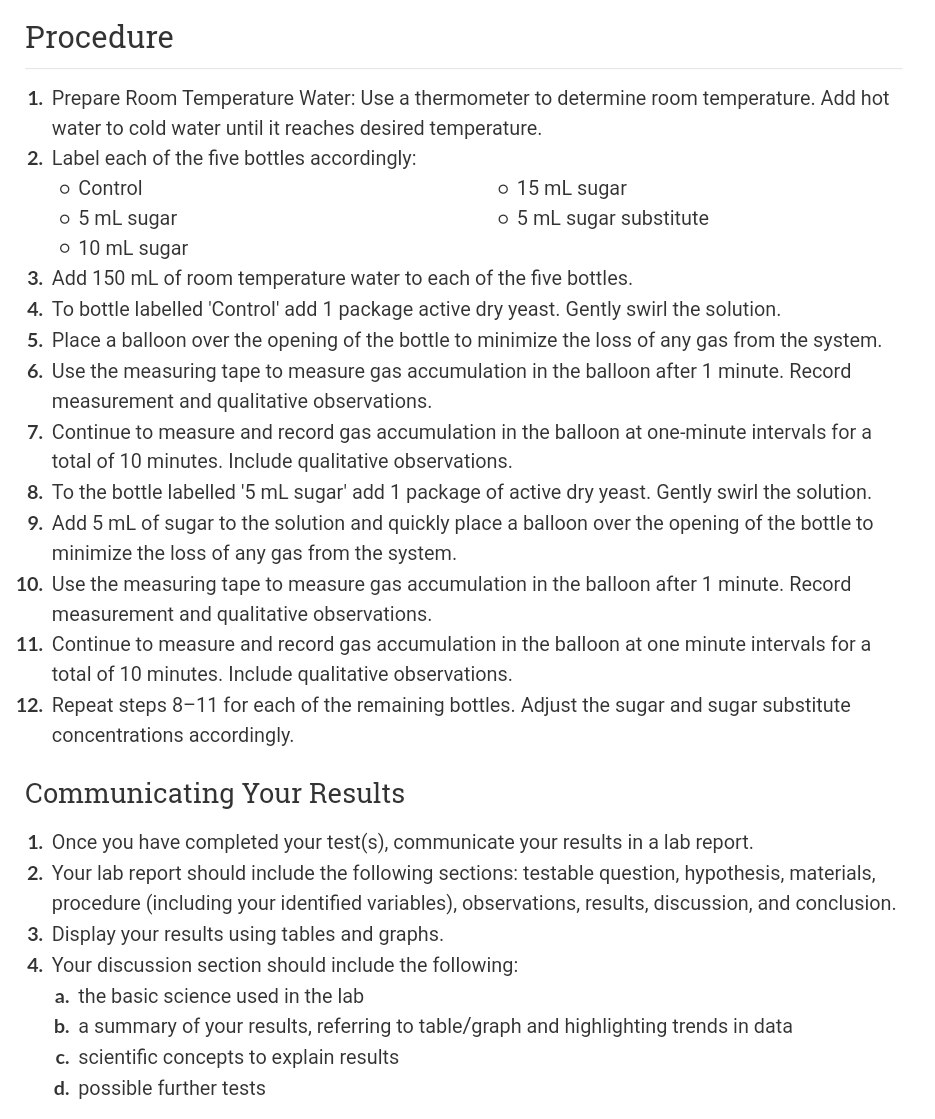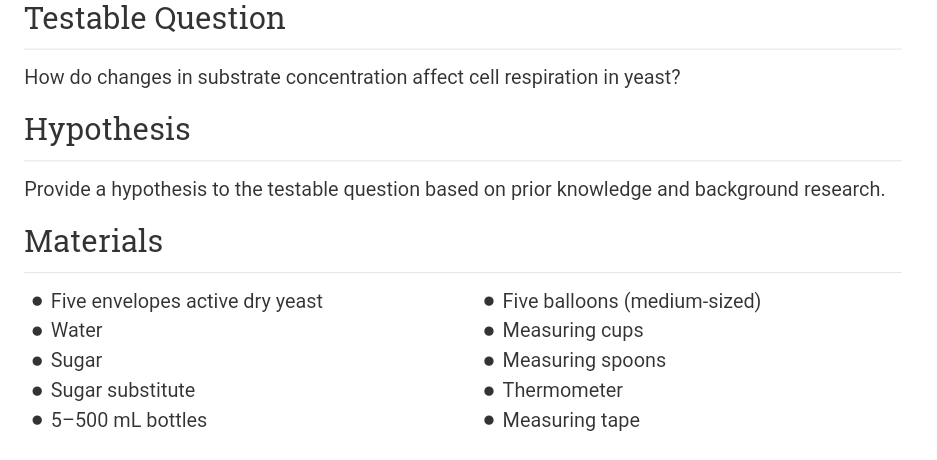Testable Question How do changes in substrate concentration affect cell respiration in yeast? Нуpothesis Provide a hypothesis to the testable question based on prior knowledge and background research.
Testable Question How do changes in substrate concentration affect cell respiration in yeast? Нуpothesis Provide a hypothesis to the testable question based on prior knowledge and background research.
Human Anatomy & Physiology (11th Edition)
11th Edition
ISBN:9780134580999
Author:Elaine N. Marieb, Katja N. Hoehn
Publisher:Elaine N. Marieb, Katja N. Hoehn
Chapter1: The Human Body: An Orientation
Section: Chapter Questions
Problem 1RQ: The correct sequence of levels forming the structural hierarchy is A. (a) organ, organ system,...
Related questions
Question

Transcribed Image Text:Procedure
1. Prepare Room Temperature Water: Use a thermometer to determine room temperature. Add hot
water to cold water until it reaches desired temperature.
2. Label each of the five bottles accordingly:
o Control
o 15 mL sugar
o 5 mL sugar
o 5 mL sugar substitute
o 10 mL sugar
3. Add 150 mL of room temperature water to each of the five bottles.
4. To bottle labelled 'Control' add 1 package active dry yeast. Gently swirl the solution.
5. Place a balloon over the opening of the bottle to minimize the loss of any gas from the system.
6. Use the measuring tape to measure gas accumulation in the balloon after 1 minute. Record
measurement and qualitative observations.
7. Continue to measure and record gas accumulation in the balloon at one-minute intervals for a
total of 10 minutes. Include qualitative observations.
8. To the bottle labelled '5 mL sugar' add 1 package of active dry yeast. Gently swirl the solution.
9. Add 5 mL of sugar to the solution and quickly place a balloon over the opening of the bottle to
minimize the loss of any gas from the system.
10. Use the measuring tape to measure gas accumulation in the balloon after 1 minute. Record
measurement and qualitative observations.
11. Continue to measure and record gas accumulation in the balloon at one minute intervals for a
total of 10 minutes. Include qualitative observations.
12. Repeat steps 8-11 for each of the remaining bottles. Adjust the sugar and sugar substitute
concentrations accordingly.
Communicating Your Results
1. Once you have completed your test(s), communicate your results in a lab report.
2. Your lab report should include the following sections: testable question, hypothesis, materials,
procedure (including your identified variables), observations, results, discussion, and conclusion.
3. Display your results using tables and graphs.
4. Your discussion section should include the following:
a. the basic science used in the lab
b. a summary of your results, referring to table/graph and highlighting trends in data
c. scientific concepts to explain results
d. possible further tests

Transcribed Image Text:Testable Question
How do changes in substrate concentration affect cell respiration in yeast?
Нуpothesis
Provide a hypothesis to the testable question based on prior knowledge and background research.
Materials
• Five envelopes active dry yeast
• Water
• Sugar
• Sugar substitute
• 5-500 mL bottles
• Five balloons (medium-sized)
• Measuring cups
• Measuring spoons
• Thermometer
• Measuring tape
Expert Solution
This question has been solved!
Explore an expertly crafted, step-by-step solution for a thorough understanding of key concepts.
Step by step
Solved in 2 steps

Knowledge Booster
Learn more about
Need a deep-dive on the concept behind this application? Look no further. Learn more about this topic, biology and related others by exploring similar questions and additional content below.Recommended textbooks for you

Human Anatomy & Physiology (11th Edition)
Biology
ISBN:
9780134580999
Author:
Elaine N. Marieb, Katja N. Hoehn
Publisher:
PEARSON

Biology 2e
Biology
ISBN:
9781947172517
Author:
Matthew Douglas, Jung Choi, Mary Ann Clark
Publisher:
OpenStax

Anatomy & Physiology
Biology
ISBN:
9781259398629
Author:
McKinley, Michael P., O'loughlin, Valerie Dean, Bidle, Theresa Stouter
Publisher:
Mcgraw Hill Education,

Human Anatomy & Physiology (11th Edition)
Biology
ISBN:
9780134580999
Author:
Elaine N. Marieb, Katja N. Hoehn
Publisher:
PEARSON

Biology 2e
Biology
ISBN:
9781947172517
Author:
Matthew Douglas, Jung Choi, Mary Ann Clark
Publisher:
OpenStax

Anatomy & Physiology
Biology
ISBN:
9781259398629
Author:
McKinley, Michael P., O'loughlin, Valerie Dean, Bidle, Theresa Stouter
Publisher:
Mcgraw Hill Education,

Molecular Biology of the Cell (Sixth Edition)
Biology
ISBN:
9780815344322
Author:
Bruce Alberts, Alexander D. Johnson, Julian Lewis, David Morgan, Martin Raff, Keith Roberts, Peter Walter
Publisher:
W. W. Norton & Company

Laboratory Manual For Human Anatomy & Physiology
Biology
ISBN:
9781260159363
Author:
Martin, Terry R., Prentice-craver, Cynthia
Publisher:
McGraw-Hill Publishing Co.

Inquiry Into Life (16th Edition)
Biology
ISBN:
9781260231700
Author:
Sylvia S. Mader, Michael Windelspecht
Publisher:
McGraw Hill Education